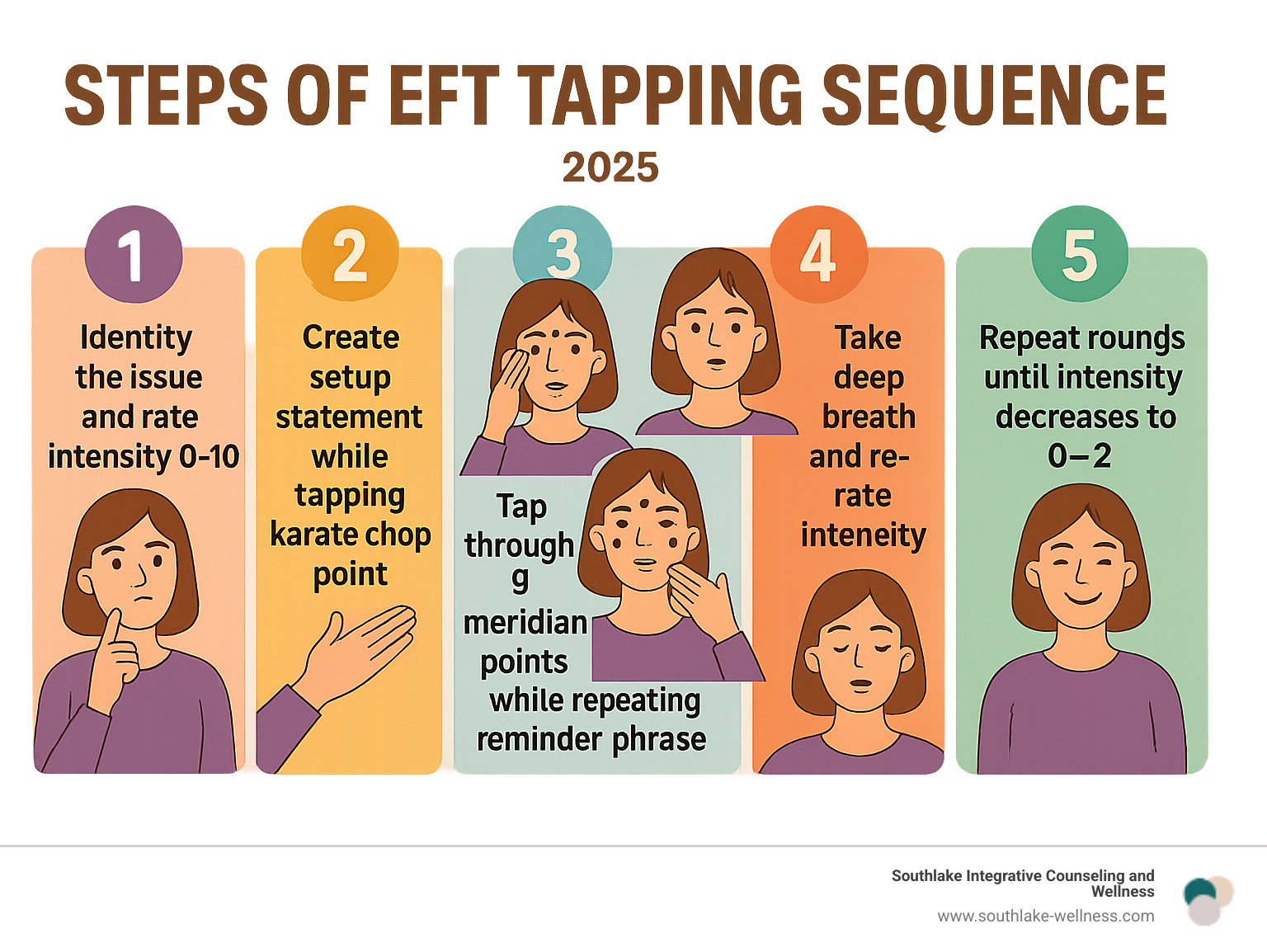
What Are Emotional Freedom Techniques and How Do They Work?
Emotional freedom techniques (EFT), also known as tapping, is a self-help method that combines gentle fingertip tapping on specific body points with focused attention on emotional or physical problems. This evidence-based approach blends elements of cognitive therapy with acupressure stimulation to help reduce stress, anxiety, and emotional distress.
Quick Overview of EFT Tapping:
- What it is: Fingertip tapping on 9 specific acupressure points while focusing on a problem
- How it works: Combines cognitive awareness with somatic stimulation to calm the nervous system
- Time needed: 5-10 minutes per session, with 5-7 rounds typically recommended
- Benefits: Research shows it can reduce cortisol by up to 43% and increase happiness by 31%
- Conditions helped: Anxiety, depression, PTSD, chronic pain, phobias, and cravings
The technique was developed in the 1990s by Gary Craig, who built upon earlier work in energy psychology and Traditional Chinese Medicine principles. Unlike acupuncture, EFT uses light tapping instead of needles, making it completely non-invasive and safe for self-application.
The basic process involves four simple steps:
- Identify the specific issue and rate its intensity (0-10 scale)
- Create a setup statement acknowledging the problem while accepting yourself
- Tap through the sequence of 9 points while repeating a reminder phrase
- Re-evaluate the intensity and repeat until it decreases
Research from over 50 studies shows EFT can be moderately to largely effective for conditions including anxiety, depression, PTSD, and chronic pain. A 2022 review found that veterans with PTSD saw 80% no longer meet clinical criteria after EFT treatment.
As Holly Gedwed, an LPC-Associate with 14 years of clinical experience specializing in trauma and addiction, I've seen how Emotional freedom techniques can complement traditional therapeutic approaches like CBT and DBT in helping clients break unhealthy patterns and build confidence. My practice focuses on customizing therapeutic approaches for each individual, recognizing that we all learn, grow, and process differently.

Understanding Emotional Freedom Techniques: The Core Principles
Emotional freedom techniques can be thought of as psychological acupressure. At Southlake Integrative Counseling and Wellness, we value the mind-body connection, and EFT embodies this philosophy by working with the same meridian points as Traditional Chinese Medicine, but using gentle fingertip tapping instead of needles.
The core principle is that emotional distress corresponds to a disruption in the body's energy system. Tapping on specific acupoints while focusing on the problem helps restore balance and calm the nervous system, acting like a reset button for your emotional state. EFT is powerful because it combines cognitive restructuring (acknowledging feelings) with somatic stimulation (tapping). This dual approach helps downregulate the fight-or-flight response that fuels stress and anxiety.
For more on how we integrate various mind-body approaches for overall well-being, explore our insights on Holistic Mental Wellness.
The History and Theory of Tapping
EFT evolved from Thought Field Therapy (TFT), developed in the 1970s by psychologist Dr. Roger Callahan. In the 1990s, Gary Craig simplified TFT's complex algorithms into a single, universal sequence, making the technique accessible to everyone. Craig's core belief was that "all negative emotions are caused by a disruption in the body's energy system."
The theory behind EFT blends ancient wisdom with modern psychology.
- Eastern Medicine: It borrows the concept of meridians from Traditional Chinese Medicine—energy pathways in the body. Tapping on acupoints along these meridians is thought to clear energetic blockages contributing to distress.
- Modern Psychology: EFT incorporates established therapeutic principles. Verbalizing the problem offers cognitive restructuring, while confronting the issue safely uses exposure techniques. The rhythmic somatic stimulation of tapping provides calming input to the nervous system, shifting it from a stressed state to a peaceful one where healing can occur.
While the energy model is debated, the combination of these elements is consistently effective. At our practice, we prioritize approaches that work, and EFT's results speak for themselves. For more on our commitment to effective, evidence-based practices, please see our page on Evidence-Based Therapy Techniques.
Your Step-by-Step Guide to Performing EFT Tapping
Ready to try Emotional freedom techniques? The beauty of EFT is its simplicity. The key is to focus on one specific issue at a time—think of it as peeling an onion, one layer at a time.

Step 1: Identify the Issue and Rate Its Intensity
First, get specific about what you're working on. It could be an emotional pain (like anxiety about a meeting) or physical pain (like a tension headache). Instead of a general "work stress," try "anxiety about my project presentation."
Next, use the Subjective Units of Distress (SUDS) scale to rate the intensity of the issue from 0 to 10, where 0 is no distress and 10 is the worst imaginable. This number is your starting point to track progress.
Step 2: Create Your Setup Statement
The setup statement acknowledges the problem while affirming self-acceptance. The formula is: "Even though I have this [problem], I deeply and completely accept myself."
While tapping the Karate Chop point (the fleshy part of your hand between your wrist and pinky), repeat your setup phrase three times. For example:
"Even though I'm nervous about this presentation, I deeply and completely accept myself."
"Even though I have this tension headache, I deeply and completely accept myself."
This self-acceptance isn't about liking the problem; it's about removing self-judgment to create space for healing.
Step 3: The Tapping Sequence
Now, use two fingertips to gently tap about 5-7 times on each of the 9 points while repeating a reminder phrase (a shortened version of your issue, like "this presentation anxiety").
The sequence of the 9 tapping points is:
- Top of Head: On your crown.
- Eyebrow: The beginning of the brow, near your nose.
- Side of Eye: On the bone at the outer corner of your eye.
- Under Eye: On the bone directly under your pupil.
- Under Nose: In the groove above your upper lip.
- Chin: In the crease between your lower lip and chin.
- Collarbone: Just below the hard ridge of your collarbone.
- Under Arm: About four inches below your armpit.
- Karate Chop: On the side of your hand.
You can tap on either or both sides of the body—whatever feels most comfortable.
Step 4: Re-evaluate and Repeat
After one full round, take a deep breath and re-rate your issue on the 0-10 scale. Has the intensity number dropped?
If your intensity is still high (above a 2), do another round. You can adjust your setup statement to "Even though I still have some of this presentation anxiety, I deeply and completely accept myself." Continue for 5-7 rounds or until the intensity feels low and manageable. Every bit of relief matters, and EFT's effects are cumulative.
The Science and Benefits of Tapping
While the practice of tapping may seem simple, the research behind Emotional freedom techniques reveals significant physiological benefits. Studies show that after just one EFT session, the stress hormone cortisol can drop by up to 43%, and participants report a 31% increase in happiness.
This happens because EFT helps shift the nervous system from the stressed fight-or-flight mode into the calm parasympathetic mode—the body's natural "rest and digest" state where healing occurs. This principle aligns with our approach to Behavioral Therapy for Stress Management, which focuses on helping the nervous system find its balance.
Conditions EFT Can Help With
Research has shown EFT to be effective for a wide range of challenges. A 2022 review of more than 50 studies confirmed its moderate to large effectiveness for many conditions, including:
- Anxiety and Depression: Multiple studies show EFT significantly reduces symptoms of anxiety. A review of 20 studies on depression found it as effective as other established treatments.
- PTSD: EFT has produced remarkable results, especially for veterans. In one study, 80% of participants with PTSD no longer met the clinical criteria after treatment.
- Chronic Pain and Phobias: Tapping can relieve physical discomfort like tension headaches and reduce the anxiety associated with phobias (e.g., public speaking, flying).
- Cravings, Insomnia, and Performance: EFT can help calm the nervous system to reduce food cravings, improve sleep, and improve focus for athletes and performers.
The Scientific Evidence for Emotional Freedom Techniques

Beyond the traditional "energy meridian" theory, the scientific evidence for EFT is grounded in measurable changes. Researchers have documented improved heart rate variability and lower blood pressure after sessions. Preliminary fMRI studies suggest that tapping may create neural changes in brain areas associated with stress and emotion.
The dramatic research on cortisol decrease is particularly compelling, as reductions of this magnitude are significant for a self-administered technique. Furthermore, a 2023 study demonstrated that EFT provided meaningful anxiety and stress reduction for healthcare professionals during the pandemic, proving its effectiveness in real-world situations. The evidence base is substantial and growing, supporting EFT as a safe and effective tool for well-being.
A Balanced View: EFT in the Context of Modern Therapy
At Southlake Integrative Counseling and Wellness, we see Emotional freedom techniques as a powerful self-help tool and complementary therapy. However, it's important to have a balanced perspective.
EFT is not a replacement for medical care or professional psychological treatment for severe conditions. Instead, think of it as a valuable addition to your wellness plan, effective for managing daily stressors and building resilience. It integrates well with other therapeutic approaches, making it a versatile tool for your emotional toolkit. For more on developing these skills, explore our approach to Emotional Regulation Therapy.
How EFT Integrates with Other Therapeutic Approaches
EFT complements many established therapies by adding a somatic component to cognitive work.
- Compared to EMDR: Both are somatic therapies for processing distressing memories. While EMDR uses bilateral stimulation (like eye movements), EFT involves tapping on acupressure points while verbalizing feelings.
- Compared to CBT: Both EFT and Cognitive Behavioral Therapy (CBT) work to identify and change negative thought patterns. EFT adds the physical tapping element, which many find helps process emotions more quickly than talk therapy alone.
In our practice, we often find a personalized blend of techniques is most effective. For more on our customized treatment plans, see our page on Cognitive Behavioral Therapy.
Potential Risks and Criticisms of Emotional Freedom Techniques
For a complete picture, it's important to acknowledge the criticisms of EFT. The primary debate concerns its theoretical basis in "energy meridians," which many scientists consider unproven pseudoscience. A Delphi poll of expert psychologists rated its predecessor as "probably discredited," and some reviews (AMSTAR 2 appraisal) have noted methodological flaws in studies.
However, even critics acknowledge the technique's observed effects may be due to established psychological principles like the placebo effect, relaxation, cognitive reframing, and exposure therapy.
EFT is generally very safe. The main risk is a brief increase in emotional intensity as buried feelings surface. This is typically temporary. However, if your feelings become overwhelming or you are dealing with severe trauma, please seek professional help. EFT is a supportive tool, not a substitute for a therapist.
Frequently Asked Questions about EFT Tapping
When people first learn about Emotional freedom techniques, they naturally have questions about what to expect and how to practice safely. At Southlake Integrative Counseling and Wellness, we believe in addressing these concerns openly and honestly. Here are the questions we hear most often from folks exploring this gentle yet powerful technique.
Is it okay to cry during or after EFT tapping?
Not only is it okay to cry during or after Emotional freedom techniques - it's actually a wonderful sign that the process is working! Many people worry when tears start flowing during their tapping session, but we encourage you to see this as your body's natural wisdom at work.
When you tap while focusing on difficult emotions, you're giving yourself permission to feel and release what you've been carrying. Those pent-up emotions that have been stored in your body finally have a safe outlet. Think of crying as your nervous system's way of letting go of emotional tension, much like how we might sigh deeply when we're stressed.
This emotional release is often followed by a sense of lightness, clarity, or calm. It's all part of the healing process, and it's completely normal. If tears come, let them flow. Your body knows what it needs to do.
How often should I practice EFT for the best results?
The beauty of Emotional freedom techniques lies in its flexibility - you can use it as needed throughout your day or establish a regular practice. For the best results, consistency tends to trump intensity. Rather than waiting for a crisis, we encourage daily practice even if it's just for a few minutes.
Many of our clients find success with brief sessions scattered throughout their day. A quick 5-minute tapping session when you wake up can set a calm tone for your morning. Another short session during lunch can help reset your stress levels. Even a gentle round before bed can help your mind unwind.
This regular practice helps with nervous system regulation, teaching your body to shift more easily out of fight-or-flight mode and into that peaceful rest-and-digest state. It's like training your emotional muscles - small, consistent efforts build lasting resilience over time.
Does it matter which side of the body I tap on?
Here's some good news that takes the pressure off - it really doesn't matter which side of your body you choose to tap on! This is one of those details that people often worry about unnecessarily. Your personal preference should guide you here.
Some practitioners like tapping both sides of certain points, believing it helps with engaging both brain hemispheres similar to other therapeutic techniques. Others find it easier to stick to one side consistently. Both approaches work beautifully.
The most important thing is making gentle contact with the points while staying focused on your issue. Don't let worrying about technique details distract you from the real work of processing your emotions. Trust yourself, pick what feels comfortable, and let the tapping do its magic.
Conclusion: Integrating Tapping into Your Wellness Journey
As we wrap up our exploration of Emotional freedom techniques, I hope you're inspired by the possibilities this simple tool offers. The beauty of EFT lies in its accessibility and how it honors the mind-body connection. With just your fingertips, you can actively participate in your own healing.
EFT gives you back control when difficult emotions arise. Whether you're dealing with everyday stress, anxiety, or chronic pain, tapping provides a way to engage directly with these challenges. It's like having a trusted friend available 24/7 to help you process whatever comes up.
At Southlake Integrative Counseling and Wellness, we've seen how Emotional freedom techniques can transform lives. Our clients often use EFT for self-regulation in overwhelming moments or as a daily routine to maintain emotional resilience. The research—from the 43% reduction in cortisol to significant improvements in PTSD and depression—shows there is real science backing up these experiences.
What excites us most about EFT is how it empowers you. You're not just receiving treatment; you're learning a skill that grows with you.

If you're ready to explore how Emotional freedom techniques might fit into your wellness journey, we encourage you to start small. Try the basic tapping sequence for minor stresses and notice what shifts.
EFT works beautifully on its own, but it can also complement other therapies. If you're curious about how tapping might integrate with professional counseling, we're here to help you create a personalized plan that honors your unique goals.
Your journey toward greater emotional freedom is deeply personal, and we're honored to be part of your support system. Explore our holistic services to find how we can help you build the life of balance and resilience you deserve.